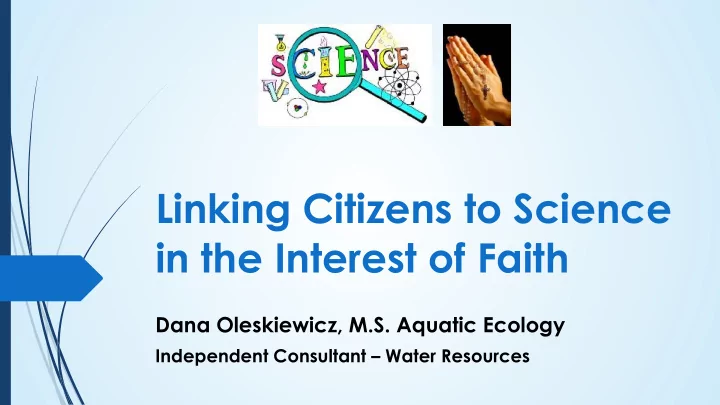

Linking Citizens to Science in the Interest of Faith Dana Oleskiewicz, M.S. Aquatic Ecology Independent Consultant – Water Resources
Science and Faith � Importance of science literacy � Setting the stage – My Story � What is citizen science? � Community-based natural resource management � Sugar Creek Method � Citizen Lake Awareness and Monitoring (CLAM) � Integrating citizen science within congregations
Science Literacy � Science – depends on who is teaching � Must be independent of religious ideas!! � Poor US ranking science & technology (NSF, 2014) � Experts no longer the experts = conspiracy theory � Opinions (beliefs), instead of facts � Bad information disseminated � Increase in anti-science legislation � http://www.newyorker.com/news/news-desk/the-mistrust-of-science
Flat Earth Society
Science Education ‘God OR Evolution’ and Bad Science Church Message
Seeking TRUTH – Culture Wars / Scientism � Creation Science � Young Earth Creationism Two � Lens = Scripture (Word) worldview � God creates, evolution false paradigms Shortsighted at polar extremes � Atheistic Naturalism � Lens = Nature (Works) � Evolution creates, God false Farsighted
Seeking TRUTH – God AND Evolution Diverse worldviews!! � Evolutionary Creationism � Faith and science reconciled � Lens = Word and Works (trust both!) � God used evolution to create
Genesis: A Beacon or a Barrier to Belief? “Jesus said to his disciples: “Things that cause people to stumble are bound to come, but woe to anyone through whom they come.” Luke 17:1 (NIV)
Building Trust Mind SCIENCE Lab Church Trust the Tool � Poor science literacy; improper hermeneutics � Respect the domains; very different doctrines � To do is to understand is to trust � Trust = Engaged……..Citizen Science
CITIZENSCIENCE.ORG Citizen Science � Scientific research by nonprofessionals � Simple data collection to full participation � Expand capacity of community efforts � Term coined in 1990s; practiced for centuries � Significant increase in popularity and legitimacy
Attributes of Good Science – Test Everything “but test them all; hold on to what is good,” 1 Thessalonians 5:21 (NIV) Science filtered through will be diluted.
Community-Based Natural Resource Management Facilitator’s Guide to Participatory Decision-Making By Sam Kaner BEST MANAGEMENT PRACTICES INFORMATION
Sugar Creek Method http://sugarcreekmethod.osu.edu/t08_pageview2/Overview.htm Alpine Cheese Factory
Sugar Creek Method � Ohio EPA – 1998 worst water quality in Ohio � Farming to blame; distrust of message � Ohio State University to investigate in 2000 � Local action and decision-making based on scientific data collected by citizens � Implemented Best Management Practices � Building community capacity and trust � Ohio EPA – Sugar Creek 2017 Study Plan
Citizen Lake Awareness and Monitoring (CLAM) http://olms.org/citizen-lake-awareness-and-monitoring/
CLAM Parameters in QDC Program Transparency Water temperature Water color Quality and lake use Temp. / DO profiles Total nutrients Total suspended solids Chlorophyll a Cyanotoxins / Harmful Algal Blooms
www.eyesonthewater.org/olms/
� Solar panels, Peach Lutheran Church, Bowling Green � Green infrastructure grant, St. Casimir Church, Cleveland � Certified Cool Congregation, First Unitarian Church, Cleveland � Energy Star National Building Competition, First Presbyterian Church, Athens � Green Team, Jerusalem Evangelical Lutheran Church, Seville � Earth Care Congregation, Common Ground Church, North Lima � LakeSide EcoEternity Forest, Lutheran Outdoor Ministries in Ohio, North Kingsville � https://ohipl.org/category/congregational-highlights/
Citizen Science in Our Churches A Win – Win – Win! � Build trust in science process � Build bridges between denominations and faiths � Build capacity for environmental protection HOW TO: � Become aware of science integrity for literacy � Partner with fellow Christians who are scientists � Advocate for sound science from the pulpit � Evaluate current efforts, internal and external � Start a congregation monitoring program
Select Literature Carlson, R.E. 2017. “Status and Trends of the Water Quality of Muskingum Watershed Conservancy District Reservoirs.” Technical � Report in collaboration with Ohio Lake Management Society. http://olms.org/wp-content/uploads/2017/07/Status-and-Trends-of-the- Water-Quality-of-Muskingham-Watershed-Conservancy-District-Reservoirs-final-071317.pdf. � Oleskiewicz, D. 2013. Citizen Scientists Monitor for Harmful Algal Blooms to Protect Human Health, Garner Stewardship, and Strengthen Partnerships [Abstract]. 2013 National Nonpoint Source Monitoring Conference, October 28-30, 2013. Oleskiewicz, D . et. al. 2012. Citizen Science in the Muskingum River Watershed, Ohio [Abstract]. The Ohio Journal of Science, Vol. 112 � (1). (pp. A-8). � Parker, J., R.H. Moore, and M. Weaver. 2007. "Land Tenure as a Variable in Community Based Watershed Projects: Some Lessons from the Sugar Creek Watershed, Wayne & Holmes County, Ohio.“ Society and Natural Resources. Iles, J., McCall R., and Oleskiewicz, D. 2007. Things to Consider When Starting a Volunteer Water Monitoring Program. WS-5-08. The � Ohio State University Extension Fact Sheet, Columbus, Ohio. Moore, R.H., B.R. Stinner, P.C. Goebel, J.S. Parker, D.M. Hudgins, D.A. McCartney, M. Weaver. 2002. “Social Creek Social Indicators: � Tapping Subheadwater TMDL Potential in the Headwaters of the Ohio River.” Presented in the proceedings of EMAP (Environmental Measurement and Assessment Program USEPA), at the Symposium 2002: The Condition of Our Nation’s Streams and Rivers from the Mountains to the Coast, May 9, Kansas City, MO. � Allaire, F., B. Stinner, D. Stinner, J. Hartzler, R.H. Moore, C. Hoy, J. Dorsey, F. Hitzhusen, and M.Weaver. 2001. “Learning Sustainable Development with a Farm Enterprise and Its Community.” Journal of Sustainable Agriculture 19:65-84. Stinner, D., R.H. Moore, and F. Hitzhusen. 1998. Report of the USDA SARE grant: “Integrating Quality of Life, Economic, and � Environmental Issues: Agroecosystem Analysis of Amish Farming". 110 pp. Carlson, R.E. and J. Simpson. 1996. A Coordinator’s Guide to Volunteer Lake Monitoring Methods. North American Lake Management � Society. 96 pp. https://www.researchgate.net/publication/244954494_A_Co- Ordinator%27s_Guide_to_Volunteer_Lake_Monitoring_Methods.
Linking Citizens to Science in the Interest of Faith “…do not let wisdom and understanding out of your Dana Oleskiewicz, sight, preserve sound M.S. Aquatic Ecology judgment and discretion;” Proverbs 3:21 (NIV) oleskiewicz@windstream.net 330-466-5631
Recommend
More recommend